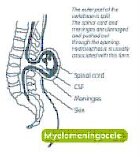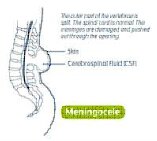|
The three main types of spina bifida (which are always present at birth) are:
» Spina Bifida Cystica (cyst-like)
The visible signs are a sac or cyst, rather like a large blister on the back, covered by a thin layer of skin.
There are two forms:
1) Myelomeningocele (meningomyelocele)
Myelomeningocele is the most serious and more common of the two forms of cystic spina bifida. Here the cyst not only contains tissue and cerebro-spinal fluid but also nerves and part of the spinal cord. The spinal cord is damaged or not properly developed. As a result, there is always some paralysis and loss of sensation below the damaged region. The amount of disability depends very much on where the spina bifida is, and the amount of affected nerve tissue involved. Bladder and bowel problems occur in most people with myelomeningocele, as the nerves come from the bottom of the spinal cord, so are always below the lesion. It is also necessary to have intact nerve pathways to the brain for complete control and sensation.
|

|
2) Meningocele
In this form, the sac contains meninges (tissues which cover the brain and spinal cord) and cerebro-spinal fluid, which bathes the central nervous system. Development of the spinal cord may be affected, but impairment is usually less severe than myelomeningocele. Meningocele is the least common form of spina bifida cystica.
|

|
» Spina Bifida Occulta (hidden form)
This is a mild form of spina bifida which is very common. Estimates vary but between 5% and 10% of people may have spina bifida occulta. It must be emphasised that, for the vast majority of those affected, having spina bifida occulta is of no consequence whatsoever. Often people only become aware that they have spina bifida occulta after having a back x-ray for an unrelated problem. However, for a few (about 1 in 1,000) there can be associated problems. See information sheet on "Spina Bifida Occulta".
|
 |
|